Hard Winter
It was a hard winter.
Sagadahoc Stories 129: 4/7/03
| The weather came off cold early, with good black ice on the river before Christmas. The Cathance tightened up before the snow flew, and we got in a week or more of splendid skating on clear crystal. Once the snow fell, it stayed, and we had a classic closed season, with the white stuff banked around the houses and dazzling the day. By February we had the thickest ice in a generation – over four foot thick in places -- all the waters turned to highways. Between the skating, skiing, and shoeing the old dogs got a good airing. |
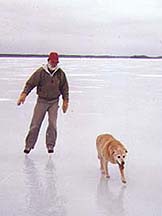 Old Dogs on Ice (Photo by David Mann) |
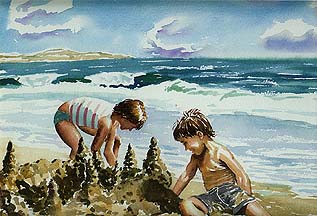 Eric and Seritha (Painting by Nancy Marstaller) |
I turned to keeping old promises after the New Year, constructing a mural a la Blackie Langley -- sort of. Eons ago we fell in love with a watercolor Nancy Marstaller did of her two kids building a sand castle on the beach. I kept trying to buy it from Nancy, and finally she gave in to my gush, but she wouldn’t take money for it, and I promised to make a double portrait of her and David in return. We would talk about the design. |
| But we never seemed to make the connection. I’d see David, or Nancy, and exchange ideas, but a coherent design wouldn’t precipitate. A year ago Nancy got together some pictures of the two of them, and I made a photo montage to work from, but we still had no vision. Their smiling faces kept me company in the shop, demanding my attention. |
| Then we encountered David and Nancy at the Bernard Langlais retrospective at the Portland Museum. David (Brooks) is a sculptor (as well as a master carpenter and TV producer), and they are as smitten with Blackie’s work as we are. Langlais was a Maine boy who went off to the urbs and began a soaring trajectory in the arts, but lost his taste for the celebrity chase, and came back downeast to reclaim his life. Married a schoolteacher and filled their world with wooden wonders. His rough board animals and mural contrivances have been an inspiration for the likes of David and me, and we bumped together at the museum show. I caromed back and forth between David and Nancy soliciting images as we filled our eyes. |
|
Nancy said that a totemic animal for David might be an osprey, and I remembered an osprey nest sculpture of his we helped hoist up into a big pine at the Maine Festival, back in the dark ages. David said a songbird playing piano would capture Nancy, and they both agreed that a Maine Island would be a fit setting. I remembered David's nest had included the leg of a piano, and an image began to congeal. Standing there surrounded by Blackie’s big constructions, I decided to work in rough wood, and two dimensions. A cross between a toy portrait and a big barnboard marquetry. Langley has been the patron saint of my ornamental excesses, and it would be fun to play in his garden again. A tasty synchronicity.
|
Of course the result didn’t look like a Langlais at all, but it had the flavor, perhaps.
| Luckily David and Nancy live in a homebuilt world where they are willing to hang another sculptural concoction, and their Bird Island now pans past as you walk to their door. Another victory for the barter economy. |
Then it was time to make another Perennial Dancer for the seasonal choreography. As this series evolves I see how a bunch of threads weave together in each image. The genesis may be an animal sighting in the field, but the symbolic material flows into the making from all directions. There are interior seasons, too.
| I’ve long thought of Fox as a personal totem. When I was little my uncle Don, who lived in England, sent me the “mask and brush” (stuffed head and tail) of a fox killed in the Royal Hunt. That bit of taxidermy hung over my bed throughout my childhood, and I’ve had a sympathetic urge for foxes ever since. Whenever I’ve encountered the line in the I Ching about the fox crossing the ice -- with the warning to be alert to the very end -- it struck home. I spend much of the winter on the ice, and there is a bloom of foxes this year -- I see one almost every time I travel at night -- so it seemed like a good time for a Fox Dancer. |
| I wanted to capture the feeling of tip-toeing over unstable ice, so I made a field of broken pans for the fox to step-and-copy across. The fox turned out to be a vixen, out raiding the hen house, with a fat bird under her arm. She was all dressed up in fox hunting garb, as you’d expect. I put the finishing touches on Crossing to Safety the afternoon of February 14. |
| Ross had been in declining health for the last few years, suffering from emphysema after a life-time of smoking, and tethered to an oxygen bottle. He hated the limitations, the weakness, the being fussed over. His wits were as sharp as ever, and he would come alive in company. But the lack of mobility and the increasing dependence made Ross irritable. I’d been spending more and more time with him because he always brought out the best in me, and I enjoyed the chaffer. Ross was the intellectual rock I’d built my own crooked house on, and the conversation was good even when we disagreed. |
| My step-mother, Carolyn, had been very protective of Ross this winter. Last year he had a couple of bad bouts with pneumonia, and she hadn’t let him out of the house this season, even to make his daily drive for the New York Times. But we had convinced Carolyn to go to New Orleans to visit my brother Lyle, who might soon be deployed to Iraq (he’s a Reserve Marine Corps Captain). My other brother, Ian, was staying with Ross, charged with watching out for him.
As soon as Ross saw the fence down, he was all for making a getaway. When we proposed an excursion for dinner on Valentine’s Day, he was eager to get out. Of course it was the coldest night of the year. But Ross was in high spirits, joking and laughing. He’d just finished the Friday puzzle in the Times (the toughest one), and was full of wry humor. |
| It was only half a block between the car and the restaurant in Hallowell, and Ross insisted Ian park and they’d walk together. Peggy had gone ahead to make sure of a table. Ian and I were slowly walking with Ross when he suddenly turned, threw his arms around Ian, and collapsed. He never made a sound. We carried Ross into a doorway and tried to resuscitate him -- there was a doctor and paramedics on the scene almost immediately -- but Ross was gone. Between on step and the next. Alert until the last instant. |
|
The morning of February 15th was still bittery cold and the open water in the tide breakers lining the river was pluming steam. I skiied a short circuit with the tears frozen on my face. The red sun rising behind the seasmoke made it look like the Cathance was on fire. When people you love die you travel some of the way into the mystery with them. You come to understand how the recent dead are our bridge to another realm. A place where they are present in the spirit, but not in the flesh. The first weeks after Ross died I spent a lot of time outside in the bright light because it was so dark inside. The world is still terribly beautiful. Each day as I made my rounds in the weather I found myself talking to Ross in my mind, about the beauty of the world. Seeing the landscape for him. Taking my ghosts out, to be their eyes. The dead were very present with me, for a spell. |
| I hadn’t realized how many times in every day I thought of Ross. Every time I pick up a newspaper or hear a story. Each time someone tells a joke. Whenever I’ve accomplished something. I keep thinking, “I’ll tell Ross about that.” Only now the telling is inside. I have to admire Ross’ perfect escape. He made a clean getaway. Ross had the last laugh. A heart attack on Valentine’s Day? The rest of us will find Valentine’s Day more difficult from now on. |
| Coming back to our own paths has been confusing and uncertain. I wanted somehow to work out my inner turmoil through my hands, but I’d already made a portrait of Ross, which was all too apt. When he retired, I’d celebrated that passage by constructing an image of him walking out of a skyscraper with a brief-case full of loot – and stepping off into space. A transformation, in the same manner as his last departure: one clean step. |
| Then I remembered my mother’s passing. I had taken just one token in memory of Pam from among her things, a Pegasus brooch she had worn when I was a child. The first piece I’d made after Pam’s death (July 4, 1991), was a flying horse mobile, which seemed to capture her free spirit and love of flying. I began to think of a talismanic image I could hold in memory of Ross. Ross was a man entirely without metaphysic, and the thought of a totemic animal would have made him bristle, and tell a joke. But that doesn’t stop my symbolisis. |
| During his war Ross enlisted in the Manitoba Dragoons, and their regimental emblem is a rampant buffalo. I rummaged through the remains of the lead soldiers and animals from my childhood, and came up with a charging bison. Later we went through Ross’ military badges and found three pot metal buffaloes from the dragoons, one for each of his sons. I set about carving a Buffalo Dancer. |
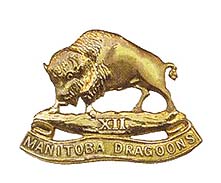 |
| It isn’t Ross, of course, and yet his memory moves in the work. This dancer is completely earth-bound, yet his bow is drawn, with the arrow of insight nocked. The great hump makes this dancer appear steadfast and intent on the task, as Ross always was. But the piece moves on beyond Ross’ passage. It is also the Buffalo Soldier, and the American Warrior. An emblem of our present belligerence. It looks a bit like a linebacker in full body armor. |
| With the Buffalo Dancer the pattern shifts. My Perennial Dancers have all been local animals dressed in human consciousness, a Sagadahoc of the spirit. This Buffalo Soldier is part of the dance, in form, but he crosses the county line. He’s part of the American Icons collection in concept, and so brings both trains of thought together. (Casey Jones you better watch your speed.) Which suggests I may have moved beyond the need for a preconceived pattern to fit the work into. Is that the first gift of Ross’ passing? That I don’t need to depend on the frame to define the work? The next piece I made completely jumped the tracks. |
| It’s been a hard winter for all of us, of course. No matter how you feel about the War in Iraq, the way this country has been wrenched, the way our self-image has been assaulted, and the way people are dying in our name, has twisted all our guts. Back in January I went to the anti-war demonstrations in Washington with two of my high school classmates, Jim Torbert and Steve Lerner, to give witness to our dismay. And the cold chill of death has been around us here all winter. When the president gave his 48-hour ultimatum my heart sank. I couldn’t continue working on the playful commission I had on the bench, and I went looking in the woodpile for some expression of my feelings. |
| This Iraqi woman is what crawled out. I think she may be The Shock in “shock and awe.” I haven’t done many unitary carvings in recent years (out of one piece of wood), except for some pocket talismans, and this is the largest single carving in the round I’ve ever done, I think. Now I have the hunger to do more. Of course I’m not tooled for this, and I’ve long since cut up my collection of suitable chunk wood, but I see figures in my head. Right now they are crying out. |
|
I’m not sure what the role of the artist is in time of war. To stand up and give witness? To hold the fort for simple truths? To enable others to find their way to the enduring places inside? To maintain a peaceful relationship with the world? To do no harm? All I can do is keep on keeping on. |
| Life in Bowdoinham keeps on, too. Recently the Merrymeeting Band offered to give the town some money if we would build a gazebo down at the landing, where we have our evening concerts in summer. A committee was conspired to consider designs and details. Such a structure had to be big enough to seat the 55 pieces of the band, but it should also be usable as a theatre stage, not overwhelm the limited grassy area, and “look like Bowdoinham.” I asked if it had to be a double-wide. |
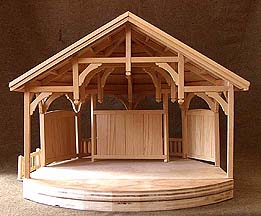 Stage Model (By Brent Zachau) |
The committee proposed a open post-and-beam structure, and we took the design puzzle down to the boys at the restaurant. Mitch immediately had a vision of a truncated gazebo with a hammerbeam framework. Brent made a scale model, adapted it with input from the committee, and committed to contract the job. When the frost comes out at the landing the town crew will break ground. Mitch will chip out the timbers. The initial donation would only cover a third of the cost, but other donations are flowing in, and it looks like the town won’t have to dip into the kitty to make this happen. The Buzzards will play for a benefit dance at the Town Hall on May 24, if you can make it. A community summer stage. |
| The hard freeze held on until late March. We had a couple of rainy days which slushed up the surface of the river and bay, then it came off frigid again, leaving a perfect skating glaze. Hank, Mr. Mann, and I took CC for a skate on the Bay, and the farther out we went the smoother the surface. Over on the Androscoggin side of the islands it was glass, and we flew like birds. Glorious. Two days later the weather turned and the Androscoggin ice was gone. |
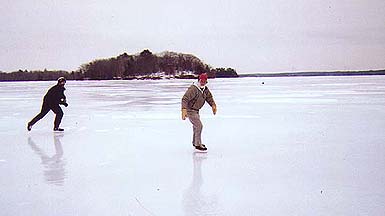 Bryce & Hank on Ice (Photo by David Mann) |
| Ice out in the Cathance was on March 31. I had April Fool’s in the pool, so Max came and got me to submit defeat when the last of the jam went out around 3PM. Now he’s the Ice Out King, and the river is full of eagles again. It’s beginning to hint of Spring, and new beginnings. Peace. |